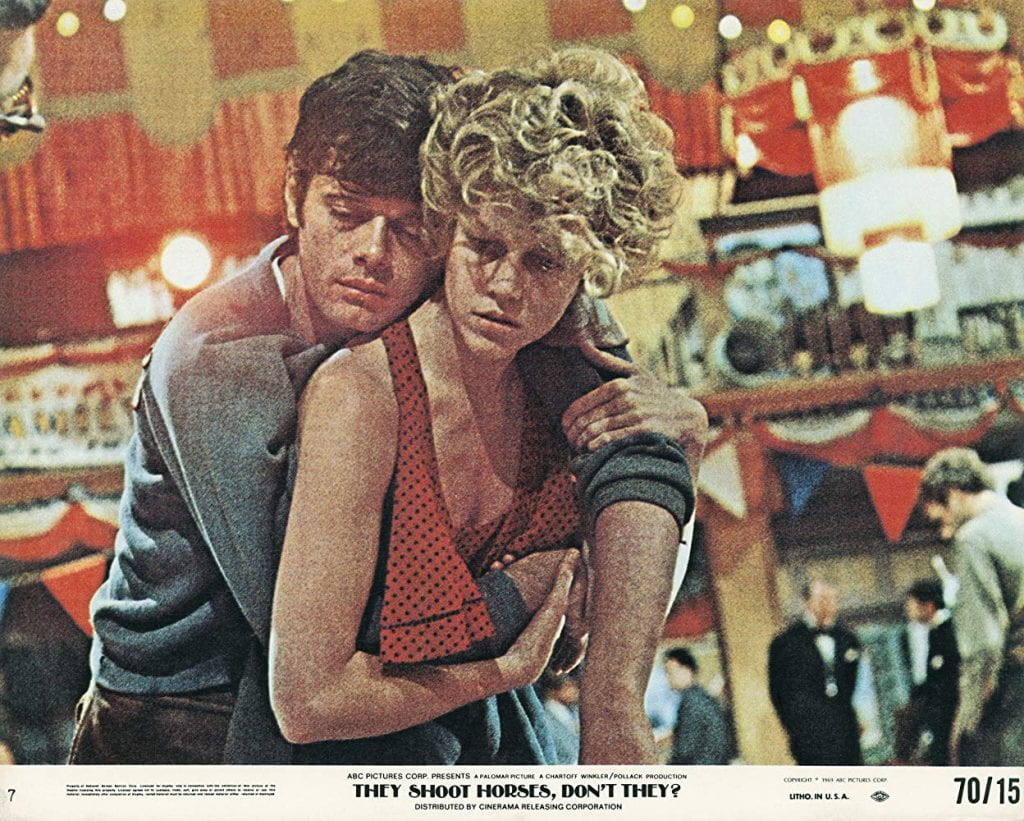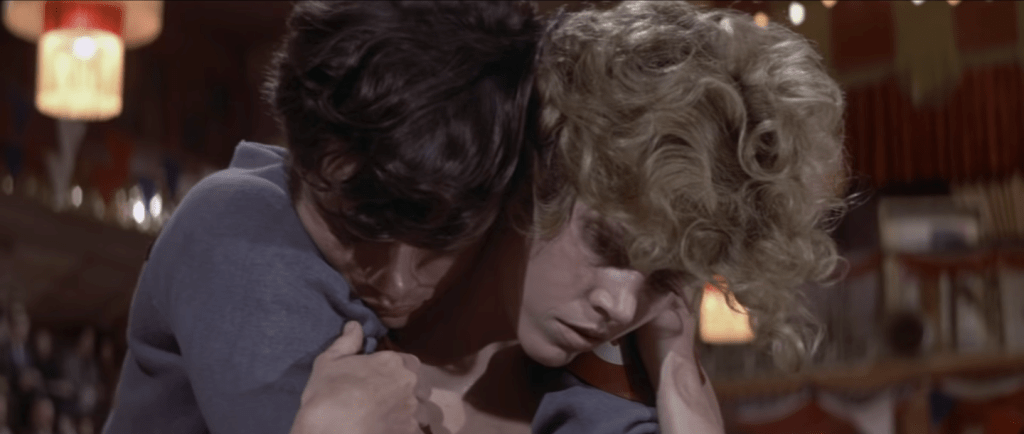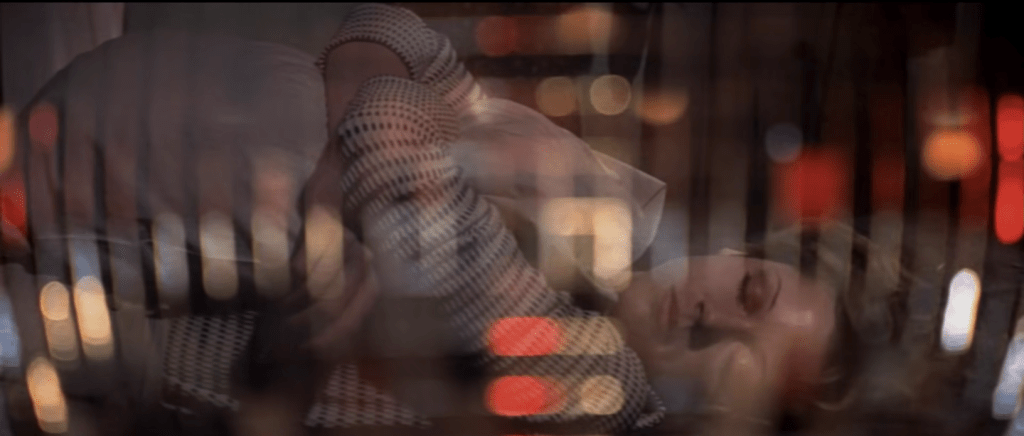
Guest post by Caleb Allison.
The rules and regulations of the Depression-era dance marathon in They Shoot Horses, Don’t They? seem simple enough. Rocky (Gig Young), the film’s imperiously duplicitous emcee, runs through them with all the vigor and verve of a carnival barker to open the film.
- Contestants get a 10-minute break every two hours.
- If you lose your dance partner, you have 24 hours to find a new one.
- You receive four regular meals and three snacks every day.
- Nurses, trainers, and an in-house doctor are at the ready.
- The prize for the last couple standing is $1,500.
While the prospect of a modern-day dance marathon may suggest an upbeat charity event, the one depicted in They Shoot Horses quickly becomes a physically and psychologically grueling fight for survival. Often called “bunion derbies” or “corn and callus carnivals,” the ostensibly lighthearted endurance spectacle of the dance marathon took on grim undertones as the realities of the Great Depression wore on into the 1930s. Rocky lays out the perverse appeal of the dance marathon’s spectators: “They just want to see a little misery out there so they can feel a little better maybe. They’re entitled to that.”
Based on a novel by Horace McCoy, They Shoot Horses reveals our collective fascination with human struggle put on display and the demoralizing illusion of Hollywood’s dream factory. Although maybe these are just two sides of the same coin. The contest, which takes place at a dance hall on the Santa Monica pier, feeds off Hollywood’s industrial waste. The contest is peppered with would-be actors clawing at the margins of celebrity and slowly unmasking Hollywood for what it really is: a glamorous illusion.
Under Sydney Pollack’s direction the film’s glittering hall, filled with energy and optimism at the outset, is transformed into a colosseum of wearied dance gladiators. Outside of the opening sequence we are confined almost entirely to the rigid hardwood of the dance hall. Exhaustion and claustrophobia inch their way in as glimpses of the outside world become more and more rare. Once our contestants agree to the rules and commit to the endeavor, their home becomes the dance floor, constant movement their mission, with only their dance partners to lean on; this is a battle of attrition.

They Shoot Horses is built around partner dynamics and at the end of the day the survival of every contestant is dependent on their dance partner. It wasn’t uncommon for these marathons to stretch on for weeks and months, so a bad fit between partners spelled disaster. Case in point: a real-life dance marathon in Somerville, PA, featured Callum DeVillier and Vonnie Kuchinski, who spent nearly half of 1933, from December to June, racking up a mind boggling 3,780 hours of continuous motion. Can you imagine dancing continuously with anyone for nearly six months?!
The pitch perfect casting of the film is led by an absolutely searing Jane Fonda in one of the grittiest performances of her career. She plays Gloria, a struggling actress beaten down by the Depression and hung out to dry by Hollywood. After losing her partner to illness before the contest even begins, she’s paired with Robert, played with doe-eyed sympathy by Michael Sarrazin. Sarrazin contrasts Fonda’s acerbic personality with deep tenderness and humanity. Throughout the film they circle each other like two stars in orbit; at times they drift apart but always find a way back to one another.
The rest of the featured couples include Alice (Susannah York) and Joel (Robert Fields), also struggling actors hoping the contest will function as a kind of casting call as bigshot Hollywood types apparently weren’t above enjoying the marathon’s sordid pleasures. Then there’s Harry (Red Buttons) and Shirl (Allyn Ann McLerie). Buttons is immediately magnetic and for a contestant in his twilight years plays the part with the gumption of a man half his age.
The last and maybe most heartbreaking couple featured are Ruby and James, played in earnest by Bonnie Bedelia and the inimitable Bruce Dern. Ruby is clearly pregnant, which is noticed by the emcee early on, and yet she’s still allowed to participate. Why? Because she’ll draw more sympathy, and money, from the crowds. Watching Ruby push her body to complete exhaustion time and again is enough to make you squirm but the guarantee of regular meals and an on-site doctor during the Depression is too good to pass up.

If hope is present at the start of this contest, it’s in the nosebleed seats with its distant cries drowned out by the roaring crowds. What we have in surplus is your basic survival instinct wrapped in tragedy. They Shoot Horses is without a doubt one of the most thrilling cinematic tragedies because it’s not trying to do anything else. There’s no shoehorned love story or redemption angle here. While many films only reveal their tragedy in the final act, this one is dyed-in-the-wool from start to finish, and if you can stomach its steadfast commitment to despair, the final moments are just astonishing.
To signal the start and end of the contestant’s breaks every two hours, what sounds like an air raid siren rings out. It’s one of many ominous markers signaling the film’s spiraling trajectory. As the contest rolls on, the alarm becomes increasingly menacing, a wartime tocsin of impending doom. Little by little, the deceits, omissions, and outright lies of the contest reveal themselves until it’s clear they’re not lapses in judgement or protocol but foundational principles. Near the end of the film, Fonda declares with absolute defeat, “Maybe it’s just the whole damn world is like Central Casting. They got it all rigged before you ever show up.”
A prominently featured disco ball (known as a mirrorball at the time) serves as the film’s symbolic artifact: a glitzy, shimmering object that draws the eye but inside lies nothing but a hollow void. Stare too closely and all you’ll find is a distorted version of yourself, but damnit if it doesn’t keep right on spinning.

I dare say even the winner of one of these dance marathons doesn’t necessarily come out on top. The win is not for the contestants but for the spectators. The win is in the pain, the grind, the misplaced hope put on display, and as you sit and watch the film you may be reminded you’re also a willing participant. The longer you watch the spectators watching the contestants, the more they all start to look like victims. The film eventually takes on a cruel and unrelenting tenor. At times it’s downright hard to watch, but then you realize this effect is only possible through the gritty, authentic performances, dizzying cinematography, and shrewd direction. It’s a masterclass in tragedy.
The only character who sees through the marathon’s farce is Fonda’s character. The tragedy lies in her clear-eyed awareness that she has no alternative but to play along. She knows her misery is someone else’s hope, and it eats her alive. Small, earnest bursts of perseverance and generosity proffered by the dwindling contestants keep hope simmering just below the surface, but the film and performances soar in its grinding moral exploitation. The fact the film received nine Academy Award nominations stands as some kind of testament to this notion.
Another version of this film, by other writers or directors, may have offered a triumphant underdog story with the prize money transforming the lives of the winners. Thankfully, this is not that version. We’re not even shown the conclusion of the contest. We’ll never know who wins, what they do with the money, or how their lives are transformed. For all we know, those final few contestants at the end of the film are still swaying meagerly on the dance floor in an alternate dimension of the Hollywood dream machine.
Early on in the marathon, Robert asks Gloria what she’d do with the prize money if they win. Her response is brutal and honest: “Maybe I’d buy some good rat poison.” The film’s triumph is in its absolute devotion to tragedy and I can’t recall tragedy ever feeling as earned as it does in They Shoot Horses, Don’t They?
They Shoot Horses, Don’t They? will screen at IU Cinema on February 25 as part of the City Lights Film Series.

Caleb Allison loves going out to the movies, especially when they are menacing, cryptic, or horrific. A PhD candidate at Indiana University, he splits his time between scholarly research and filmmaking. He has a passion for the look and feel of super 8mm and 16mm film and uses them whenever the universe aligns, and will watch anything by Andrei Tarkovsky, Terrence Malick, or John Carpenter anytime, anywhere.